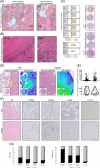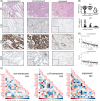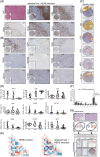Immunologic landscape of human hepatic hemangiomas and epithelioid hemangioendotheliomas
- PMID: 38206210
- PMCID: PMC10786595
- DOI: 10.1097/HC9.0000000000000359
Immunologic landscape of human hepatic hemangiomas and epithelioid hemangioendotheliomas
Abstract
Background: The missing requirement for resection for the majority of hepatic hemangiomas (HH) and tissue scarcity for rare diseases such as hepatic epithelioid hemangioendotheliomas (HEHE) complicate the characterization of the spatial immunovascular niche of these benign and malignant vascular neoplastic diseases.
Methods: Two tissue cohorts containing 98 HHs and 13 HEHEs were used to study entity-specific and disease stage-specific endothelial cell (EC) phenotype and immune cell abundance. Using semiquantitative assessment, annotation-based cell classifiers, digital cell detection on whole slides, and tissue microarrays, we quantified 23 immunologic and vascular niche-associated markers and correlated this with clinicopathologic data.
Results: Both HH and HEHE ECs were characterized by a CD31high, CD34high, FVIII-related antigenhigh expression phenotype with entity-specific expression differences of sinusoidal EC markers Stabilin1, Stabilin2, CD32, and Lymphatic Vessel Endothelial Hyaluronan Receptor 1 (LYVE-1). Cell detection identified an HH margin-prevailing immunologic response dominated by Myeloperoxidase+ (MPO+) macrophages, CD3+ and CD8+ T cell subsets, and B cells (CD20+, CD79A+). In HEHE, increased CD68+ and CD20+ cell demarcation of lesion margins was observed, while CD3+ and CD8+ T cells were equally detectable both marginally and intralesionally. Stage-specific pairwise correlation analysis of HH and HEHE revealed disease entity-specific immunologic infiltration patterns as seen by high CD117+ cell numbers in HH, while HEHE samples showed increased CD3+ T cell infiltration.
Conclusions: ECs in HH and HEHE share a continuous EC expression phenotype, while the expression of sinusoidal EC markers is more highly retained in HEHE. These phenotypic differences are associated with a unique and disease-specific immunovascular landscape.
Copyright © 2024 The Author(s). Published by Wolters Kluwer Health, Inc. on behalf of the American Association for the Study of Liver Diseases.
Conflict of interest statement
The authors have no conflicts to report.
Figures





Similar articles
-
Comparison of the clinical and MRI features of patients with hepatic hemangioma, epithelioid hemangioendothelioma, or angiosarcoma.BMC Med Imaging. 2020 Jun 29;20(1):71. doi: 10.1186/s12880-020-00465-4. BMC Med Imaging. 2020. PMID: 32600273 Free PMC article.
-
Kasabach-Merrit syndrome and adult hepatic epithelioid hemangioendothelioma an unusual association.J Hepatol. 2005 Feb;42(2):282-3. doi: 10.1016/j.jhep.2004.09.007. J Hepatol. 2005. PMID: 15664259
-
Digital Staging of Hepatic Hemangiomas Reveals Spatial Heterogeneity in Endothelial Cell Composition and Vascular Senescence.J Histochem Cytochem. 2022 Jul;70(7):531-541. doi: 10.1369/00221554221112701. Epub 2022 Jul 9. J Histochem Cytochem. 2022. PMID: 35815421 Free PMC article.
-
The challenges of hepatic epithelioid hemangioendothelioma: the diagnosis and current treatments of a problematic tumor.Orphanet J Rare Dis. 2024 Nov 30;19(1):449. doi: 10.1186/s13023-024-03354-z. Orphanet J Rare Dis. 2024. PMID: 39616351 Free PMC article. Review.
-
Laparoscopic resection of hepatic epithelioid hemangioendothelioma: report of eleven rare cases and literature review.World J Surg Oncol. 2020 Oct 29;18(1):282. doi: 10.1186/s12957-020-02034-z. World J Surg Oncol. 2020. PMID: 33121478 Free PMC article. Review.
References
-
- Mocchegiani F, Vincenzi P, Coletta M, Agostini A, Marzioni M, Baroni GS, et al. Prevalence and clinical outcome of hepatic haemangioma with specific reference to the risk of rupture: A large retrospective cross-sectional study. Dig Liver Dis. 2016;48:309–314. - PubMed
-
- Trotter JF, Everson GT. Benign focal lesions of the liver. Clin Liver Dis. 2001;5:17–42; v. - PubMed
-
- Belli L, De Carlis L, Beati C, Rondinara G, Sansalone V, Brambilla G. Surgical treatment of symptomatic giant hemangiomas of the liver. Surg Gynecol Obstet. 1992;174:474–478. - PubMed
-
- Toro A, Mahfouz AE, Ardiri A, Malaguarnera M, Malaguarnera G, Loria F, et al. What is changing in indications and treatment of hepatic hemangiomas. A review. Ann Hepatol. 2014;13:327–339. - PubMed
-
- Hasan HY, Hinshaw JL, Borman EJ, Gegios A, Leverson G, Winslow ER. Assessing normal growth of hepatic hemangiomas during long-term follow-up. JAMA Surg. 2014;149:1266–1271. - PubMed
Publication types
MeSH terms
LinkOut - more resources
Full Text Sources
Medical
Research Materials
Miscellaneous

